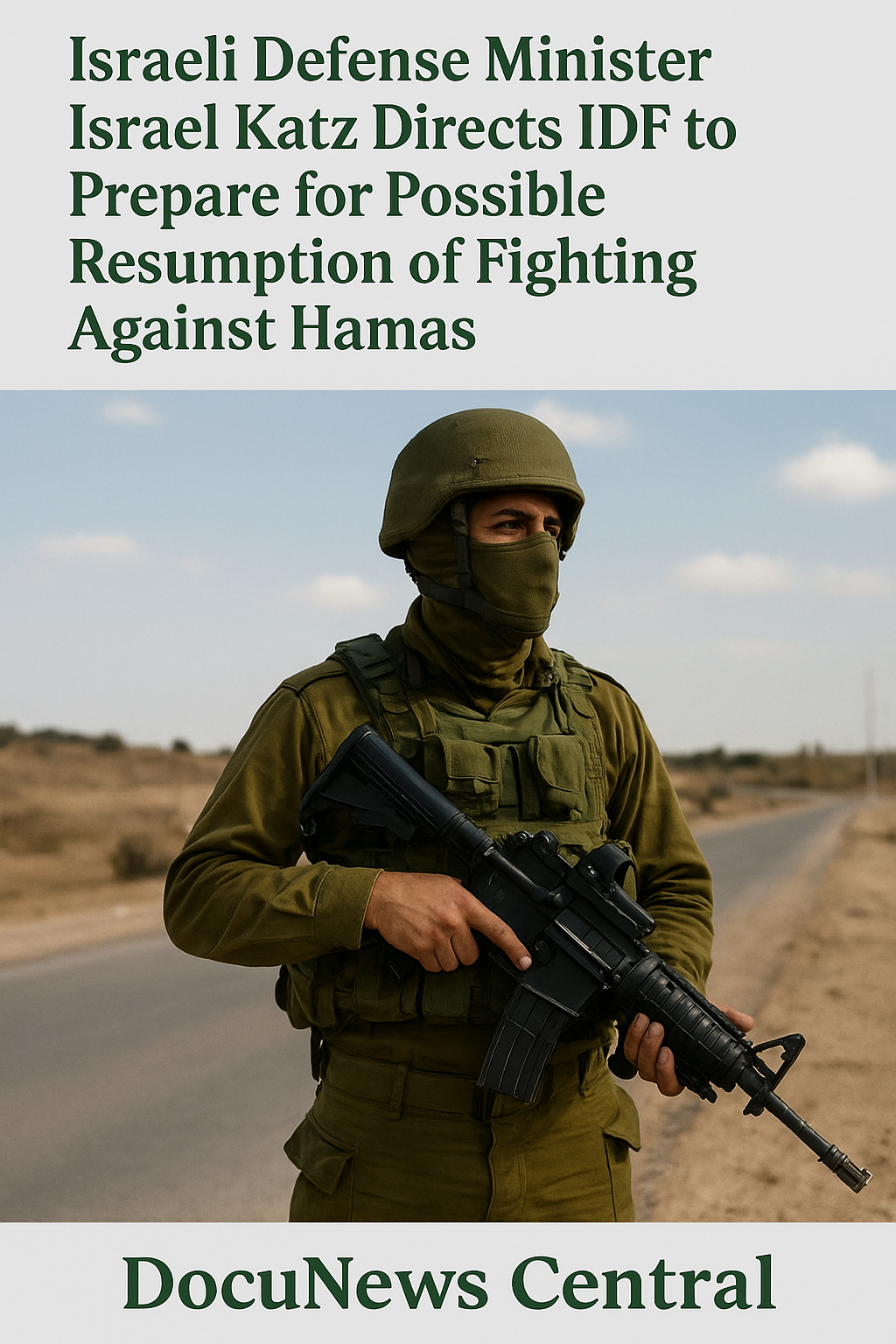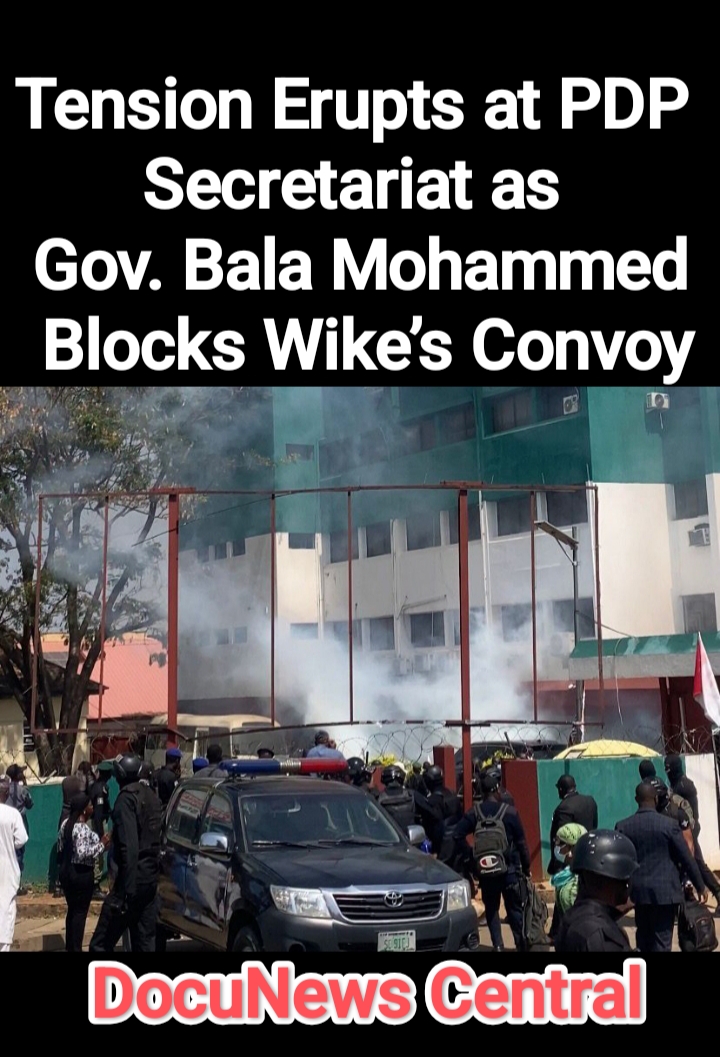

By DocuNews Central
In a move that has stirred global attention, Israeli Defense Minister Israel Katz announced that he has instructed the Israel Defense Forces (IDF) to prepare a detailed operational plan to resume fighting against Hamas if circumstances demand it. This directive, according to credible reports from The Times of Israel, Reuters, and The Guardian, underscores the fragile nature of the ceasefire and the potential for renewed hostilities in the Gaza Strip.
The announcement follows weeks of tension and uncertainty surrounding the ceasefire agreement between Israel and Hamas. While the truce has temporarily halted active conflict, officials on both sides remain cautious, signaling that peace may still be fleeting.

Israeli soldier standing guard — Photo credit: DocuNews Central
Israel Katz’s Statement and Strategic Directive
According to reports from The Times of Israel, Defense Minister Israel Katz confirmed that he had ordered the IDF to draw up a comprehensive plan aimed at defeating Hamas should the militant group fail to comply with the conditions of the U.S.-backed peace proposal. Katz emphasized that Israel must be ready for every scenario, including the possibility of a renewed military campaign if Hamas continues to pose a threat.
“If Hamas does not uphold the agreements and continues its hostile actions, Israel will not hesitate to act,” Katz was quoted as saying. His statement has been interpreted as both a warning and a precaution, emphasizing readiness without an immediate escalation.
Why the Directive Matters Now
This move comes amid growing international pressure to maintain stability in Gaza and to avoid a return to full-scale conflict. However, Israel’s security establishment remains vigilant. The ongoing humanitarian crisis, coupled with Hamas’s military presence, makes a fragile peace difficult to sustain. Transitioning between war and peace requires caution, diplomacy, and readiness — a balance that Katz appears determined to maintain.
Furthermore, the defense minister’s decision aligns with Israel’s long-standing policy of deterrence and preparedness. The government seeks to project strength while allowing room for diplomatic engagement. This approach, though criticized by some international observers, reflects Israel’s view that only a credible military deterrent can prevent further aggression from Hamas.
International Reactions and Media Coverage
International media outlets quickly picked up Katz’s statement, interpreting it through different lenses. Reuters described the move as a sign that “Israel remains prepared for renewed hostilities if ceasefire conditions collapse.” Meanwhile, The Guardian noted that Hamas’s refusal to cooperate with ongoing hostage negotiations could easily trigger a new round of conflict.
Similarly, ABC News confirmed that the defense ministry has “instructed the IDF to remain on alert and fully equipped to resume operations if necessary.” These outlets collectively highlight the seriousness of the Israeli position while emphasizing that the current goal remains peace and stability.
The Context Behind the Ceasefire
To understand Katz’s statement, one must first grasp the context behind the ceasefire. Following months of intense fighting, mediated negotiations led to a fragile truce between Israel and Hamas. Under the agreement, Hamas was expected to release remaining hostages and halt rocket fire, while Israel was to allow limited humanitarian aid into Gaza.
However, the peace remains tenuous. Reports suggest that Hamas has not fully met its obligations, leading Israeli officials to question the group’s intentions. As the situation evolves, Katz’s order to prepare for renewed fighting acts as both a safeguard and a strategic reminder that Israel is unwilling to tolerate further violations.
Strategic Readiness and Military Planning
The directive given to the IDF involves more than just tactical adjustments. According to defense analysts, it includes a full review of military logistics, supply chains, intelligence operations, and potential coordination with international allies. This level of preparedness ensures that Israel can respond quickly should hostilities resume.
Moreover, maintaining readiness allows the government to negotiate from a position of strength. It demonstrates that Israel’s commitment to peace is not a sign of weakness but a conscious choice balanced by the ability to defend itself when necessary.
Hamas’s Response and Palestinian Reactions
While Israel prepares for a potential escalation, Hamas leaders have accused Katz and the Israeli government of “provoking instability.” Statements from Hamas-linked media outlets suggest that the group views the directive as an intimidation tactic. Yet, Palestinian civilians, weary of repeated cycles of violence, continue to call for lasting peace and humanitarian relief.
Meanwhile, aid organizations working in Gaza express concern that renewed conflict could worsen the already dire humanitarian conditions. The United Nations and the International Red Cross have repeatedly appealed for restraint on both sides.
U.S. and Global Diplomatic Efforts
The United States remains a central figure in mediating the fragile peace. The U.S.-sponsored plan — which requires Hamas to disarm and release hostages — is seen as the foundation for longer-term stability in the region. However, Washington has also reaffirmed Israel’s right to self-defense should Hamas violate the truce.
Other international actors, including Egypt and Qatar, continue to facilitate indirect talks between the two parties. These diplomatic efforts aim to prevent the kind of escalation that Katz’s statement hints at. Still, many analysts caution that diplomacy alone may not hold if either side loses faith in the peace process.
Israel’s Security Perspective
From Israel’s point of view, the directive to prepare for renewed fighting is both logical and necessary. The government’s primary responsibility is to protect its citizens, and given Hamas’s history of aggression, Israel’s security apparatus cannot afford complacency. For years, the IDF has maintained a doctrine of readiness, ensuring it can respond within hours to emerging threats.
Experts argue that such preparedness has often prevented larger conflicts. When adversaries know that Israel is capable of swift, decisive action, they are less likely to initiate hostilities. Therefore, Katz’s directive may serve more as a deterrent than a trigger for new war.
Public Opinion in Israel
Within Israel, reactions to Katz’s announcement are mixed but largely supportive. Many Israelis see the directive as a prudent step toward national security. Families of soldiers, in particular, appreciate the government’s caution in maintaining readiness while avoiding unnecessary aggression.
However, some political figures and peace activists worry that even cautious preparations could escalate tensions. They argue that language matters and that framing readiness as “defeat of Hamas” might inflame rather than deter hostilities. Despite these concerns, most Israelis agree that Hamas cannot be trusted without clear enforcement mechanisms.
Potential Scenarios Going Forward
Analysts outline several possible outcomes following Katz’s directive:
- Scenario 1: Hamas complies with the peace plan, leading to extended calm and reconstruction efforts in Gaza.
- Scenario 2: Hamas refuses to release hostages or continues militant activities, prompting Israel to resume limited strikes.
- Scenario 3: Full-scale hostilities resume if diplomatic talks collapse completely.
Each scenario carries different implications for regional stability, civilian safety, and international relations. While the first scenario remains the most desirable, history suggests that the second or third could unfold if trust erodes.
The Role of International Media and Verification
Global media coverage has played a crucial role in verifying and contextualizing Katz’s statement. Outlets such as Reuters, The Guardian, and ABC News have cross-verified the information, ensuring that readers receive accurate reporting rather than social media speculation. Their reports confirm that the directive is conditional and does not signal immediate war.
Moreover, the transparency with which these outlets present Israel’s position helps reduce misinformation. In an era of online propaganda and deepfake content, factual clarity remains essential for informed public discourse.
DocuNews Central’s Analysis
At DocuNews Central, our analysis indicates that Katz’s directive reflects a broader shift toward strategic prudence in Israeli defense policy. Rather than escalating tensions, it signals a desire to maintain leverage while allowing diplomacy to work. Nevertheless, the situation remains delicate, and the coming weeks will determine whether both sides can uphold the fragile peace.
Given the volatility of the region, preparedness may prove to be Israel’s best strategy. By instructing the IDF to stay ready, Katz ensures that Israel can protect its interests while giving peace negotiations the chance they need to succeed.
Conclusion: A Delicate Balance Between Peace and Preparedness
Israel’s latest move underscores a timeless truth: peace is never guaranteed, and vigilance remains the cornerstone of national security. As the world watches closely, Israel must navigate this critical moment with both strength and restraint. Hamas, too, must recognize that compliance with international agreements is the only sustainable path forward.
While the threat of renewed conflict looms, the possibility of lasting peace still exists. What happens next depends on the willingness of both sides to honor their commitments. Until then, Israel’s preparation serves as a reminder that security and diplomacy must go hand in hand.
Sources: The Times of Israel, Reuters, The Guardian, ABC News
© Copyright Reserved, DocuNews Central






